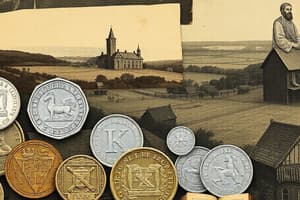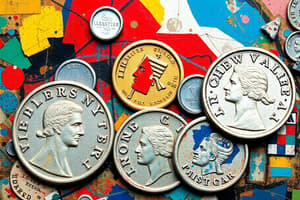Podcast
Questions and Answers
What critical factor enabled Adam Staples and his group to discover the Chew Valley Hoard in Somerset, England?
What critical factor enabled Adam Staples and his group to discover the Chew Valley Hoard in Somerset, England?
- A pre-existing map indicating the location of potential ancient coin caches in the region.
- Possession of a modern metal detector, specifically used to search a farmer's field in Chew Valley. (correct)
- Their comprehensive knowledge of metal detecting laws and regulations within the UK.
- The use of advanced signal processing techniques to differentiate coin types from other metals.
How did the discovery of the Chew Valley Hoard directly financially benefit the local community beyond the finders and landowner?
How did the discovery of the Chew Valley Hoard directly financially benefit the local community beyond the finders and landowner?
- The South West Heritage Trust's acquisition increased property values in Chew Valley.
- It provided funds to restore historical buildings in Somerset, stimulated by the heightened interest in local history.
- It boosted local tourism to heritage sites, increasing revenue for nearby businesses.
- It facilitated the creation of new archaeology jobs in the South West Heritage Trust. (correct)
What historical context is most significantly illuminated by the variety of mint locations represented in the Chew Valley Hoard?
What historical context is most significantly illuminated by the variety of mint locations represented in the Chew Valley Hoard?
- The widespread adoption of a standardized currency system throughout Anglo-Saxon England.
- The political fragmentation and regional economies of England immediately before the Norman Conquest. (correct)
- The extensive trade networks across England immediately prior to the Norman Conquest.
- The economic policies enacted by William I to consolidate power after the Norman Conquest.
What immediate historical event provides the most direct context for understanding the significance of the Chew Valley Hoard?
What immediate historical event provides the most direct context for understanding the significance of the Chew Valley Hoard?
What can historians infer from the Chew Valley Hoard about the immediate aftermath of the Norman Conquest beyond the change in rulers?
What can historians infer from the Chew Valley Hoard about the immediate aftermath of the Norman Conquest beyond the change in rulers?
Flashcards
Chew Valley Hoard
Chew Valley Hoard
A collection of 2,584 silver pennies discovered in Chew Valley, England, dating back to the 11th century.
Anglo-Saxon
Anglo-Saxon
Relating to the period of English history before the Norman Conquest of 1066.
Norman Conquest
Norman Conquest
The invasion and occupation of England by William the Conqueror in 1066.
King Harold II
King Harold II
Signup and view all the flashcards
William I
William I
Signup and view all the flashcards
Study Notes
- In January 2019, Adam Staples and friends discovered a trove of silver coins in Chew Valley, Somerset, England, using a metal detector.
- Staples, an auctioneer specializing in ancient coins, recognized the find as extraordinary.
- The discovered collection, known as the Chew Valley Hoard, consists of 2,584 silver pennies dating back to the 11th century.
- On October 23, 2024, the South West Heritage Trust acquired the coins for $5.5 million, classifying it as Britain's most valuable treasure find.
- Staples and his friends are set to receive half of the money, amounting to approximately $400,000 each.
- The landowner will receive the remaining half, which is about $2.8 million.
- Minted in 46 locations across England between 1066 and 1068, the coins symbolize a significant period of change after the Norman Conquest of 1066.
- The Norman Conquest marked the defeat of Anglo-Saxon King Harold II by William I.
- About half the coins depict King Harold, while the other half feature William I, who ruled until 1087.
- Experts believe the coins were buried for safekeeping.
- It is believed the coins were hidden due to the people of Exeter rebelling against William in 1068 and Harold's sons launching attacks from Ireland into Somerset.
- Cutting coins in half was a common practice to create smaller denominations.
- Gareth Williams, a British Museum curator, estimates that the Chew Valley Hoard's value was equivalent to 500 sheep or the annual income of a large estate.
- The Chew Valley Hoard will be displayed in museums throughout the UK, starting with the British Museum in London in November 2024, before being permanently housed at the South West Museum of Somerset.
Studying That Suits You
Use AI to generate personalized quizzes and flashcards to suit your learning preferences.





